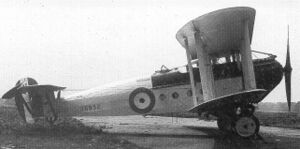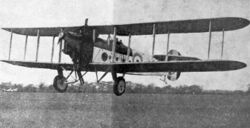Engineering:Avro 549 Aldershot
| Aldershot | |
|---|---|

| |
| The first prototype in 1924, modified to production standard | |
| Role | Heavy Bomber |
| Manufacturer | Avro |
| First flight | October 1921 |
| Introduction | July 1924 |
| Retired | March 1926 |
| Status | Retired |
| Primary user | Royal Air Force |
| Produced | 17 |
| Variants | Avro Andover |
The Avro 549 Aldershot was a British single-engined heavy bomber aircraft built by Avro.
Development and design
The Aldershot was designed to meet the 1920 British Specification 2/20 for a heavy long-range day and night bomber to be powered by a Rolls-Royce Condor engine.[1] The specification required a range of 500 miles (800 km) and a bombload of 2,000 lb (900 kg), originally comprising a single World War I vintage 1,800 lb (820 kg) SN bomb, but then changed to four 500 lb (230 kg) bombs carried externally or eight 250 lb (114 kg) bombs internally.[2][3] The Air Ministry gave Avro a contract for two prototypes, designated Aldershot I, on 2 December 1920, in competition with the de Havilland Derby.[1]
The first prototype flew at Hamble Aerodrome near Southampton in October 1921.[4] As a result of test flying, the fuselage was lengthened by 6 ft (2 m) in order to improve directional control, being displayed in this form at the RAF Display at Hendon on 24 June, the second prototype flying in July with the lengthened fuselage and a modified undercarriage.[4][5]
The first prototype was modified as a testbed for the water-cooled Napier Cub engine, in this form becoming the Aldershot II, flying on 15 December 1922.[6] It was later used to test the slow-revving 850 hp (630 kW) Beardmore Typhoon I inline engine, flying in this form on 10 January 1927.[7]
The Aldershot was a three-bay biplane, with a steel-framed fuselage structure with plywood and fabric covering, and wooden wings. The pilot and navigator were seated side by side in a cockpit behind the upper wing trailing edge, with additional accommodation for the navigator who was also the bomb-aimer, in a cabin inside the fuselage, which was provided with four circular windows on each side. A gunner sat in a separate cockpit behind the pilot, and was armed with a Lewis gun on a Scarff ring. Another Lewis gun could be fitted to a ventral mounting in the cabin, while there was provision for a fixed, forward-firing Vickers machine gun operated by the pilot, although this was rarely fitted.[4] A bomb bay forward of the cabin could hold eight 250 lb (114 kg) bombs, with larger bombs being carried externally under the fuselage.[8]
The Aldershot also formed the basis for the Avro Andover transport, which used the same wings, tail and powerplant but had a new fuselage.[9]
Operational history
When it was evaluated against the de Havilland Derby, the Aldershot proved to be the superior aircraft,[10] with the mixed-construction Aldershot being about 800 lb (360 kg) lighter than the all-wooden Derby, which had no provision for carrying its bombload internally, or for any ventral armament.[11]
On 26 January 1923, the Air Ministry ordered 15 aircraft under the designation Aldershot III.[12] The only operator of the aircraft was No. 99 Squadron RAF which reformed on 1 April 1924,[13] receiving its Aldershots from July that year.[9] The Aldershot was mainly used for night flying, but occasionally flew day bombing exercises. Unlike the other members of the RAF's heavy bomber force, it was operated in an all-silver colour scheme, rather than the dark-green NIVO scheme usually used for night operations.[14] By 1925, the Air Ministry had decided that heavy bombers should have multiple engines, and 99 Squadron started to receive the twin-engined Handley Page Hyderabad in January 1926, with the Aldershots being completely replaced in Squadron service by March that year.[9]
Variants
- Avro 549 Aldershot I
- Prototype. Two built.
- Avro 549A Aldershot II
- First prototype modified with 1,000 hp (746 kW) Napier Cub engine.
- Avro 549B Aldershot III
- Production version. 15 built. One modified with metal wings as Avro 549M.[15]
- Avro 549C Aldershot IV
- First prototype modified with Beardmore Typhoon engine.
Operators
 United Kingdom
United Kingdom
- Royal Air Force
- No. 99 Squadron RAF
Specifications (Aldershot III)
Data from Avro Aircraft since 1908[16]
General characteristics
- Crew: 3
- Length: 45 ft 0 in (13.72 m)
- Wingspan: 68 ft 0 in (20.73 m)
- Height: 15 ft 3 in (4.65 m)
- Wing area: 1,064 sq ft (98.8 m2)
- Empty weight: 6,310 lb (2,862 kg)
- Max takeoff weight: 10,950 lb (4,967 kg)
- Powerplant: 1 × Rolls-Royce Condor III V-12 liquid-cooled piston engine, 650 hp (480 kW)
- Propellers: 2-bladed fixed-pitch propeller
Performance
- Maximum speed: 110 mph (180 km/h, 96 kn)
- Cruise speed: 92 mph (148 km/h, 80 kn)
- Range: 625 mi (1,006 km, 543 nmi)
- Service ceiling: 14,500 ft (4,400 m)
Armament
- Guns: 1 × .303 in (7.7 mm) Lewis Gun in rear cockpit, provision for 1 × Lewis gun in ventral position and provision for 1 × forward-firing Vickers machine gun.[17]
- Bombs: up to 2,000 lb (910 kg) of bombs
See also
Aircraft of comparable role, configuration and era
- de Havilland Derby
Related lists
- List of aircraft of the Royal Air Force
Notes
- ↑ 1.0 1.1 Jarrett 1993, p.9.
- ↑ Mason 1994, p.136.
- ↑ Sharpe, Michael. Biplanes, Triplanes, and Seaplanes. London, England: Friedman/Fairfax Books , 2000. ISBN:1-58663-300-7.
- ↑ 4.0 4.1 4.2 Mason 1994, p.137.
- ↑ Jarrett 1993, p.11.
- ↑ Jackson 1990, p.195.
- ↑ Jackson 1990, p.197.
- ↑ Jarrett 1993, pp.9–10.
- ↑ 9.0 9.1 9.2 Thetford 1993, p.10.
- ↑ Thetford 1993, p.7.
- ↑ Mason 1994, pp.138–139.
- ↑ Thetford 1993, p.8.
- ↑ Lewis 1959, p.49.
- ↑ Thetford 1993, p.8–9.
- ↑ Mason 1994, p.138.
- ↑ Jackson 1990, p.198.
- ↑ Jarrett 1993, pp.28.
References
- Jackson, A.J. (1990). Avro Aircraft since 1908 (Second ed.). London: Putnam. ISBN 0-85177-834-8.
- Lewis, Peter (1959). Squadron Histories: R.F.C, R.N.A.S and R.A.F. 1912–59. London: Putnam.
- Mason, Francis K. (1994). The British Bomber since 1914. London: Putnam. ISBN 0-85177-861-5.
- Jarrett, Philip (March 1993). "By Day and By Night: Part 10 Avro Aldershot Development History". Aeroplane Monthly (London: IPC) 24 (3): 8–13, 28. ISSN 0143-7240.
- Thetford, Owen (April 1993). "By Day and By Night: Part 11 Avro Aldershot Service History". Aeroplane Monthly (London: IPC) 24 (4): 6–10. ISSN 0143-7240.
- The Illustrated Encyclopedia of Aircraft (Part Work 1982–1985). Orbis Publishing.
External links
- Avro Aldershot – British Aircraft Directory
 |



